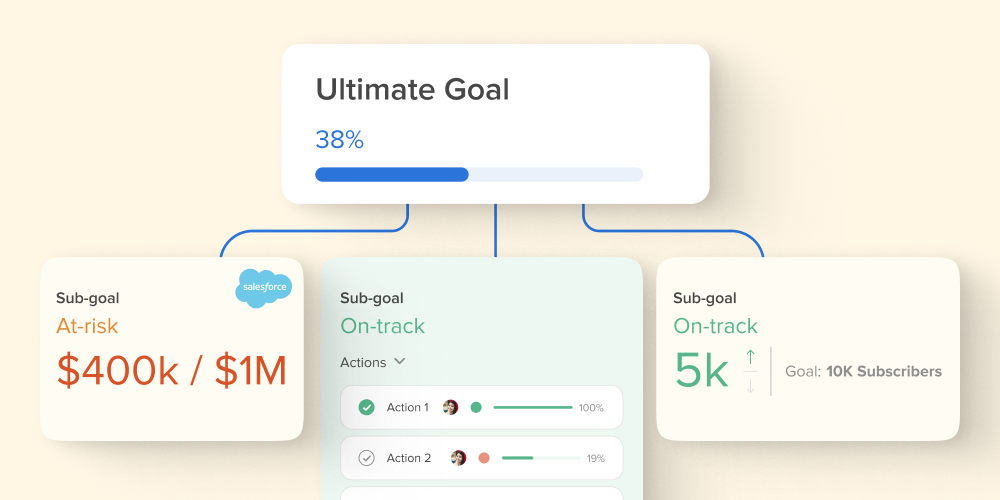Successful companies today need to be goal-driven and analytic-oriented. Working by the seat of your pants can get you moving forward, but more is required to reach your company’s established KPIs or metrics. Setting realistic and achievable project goals is a crucial driver to success and pushes you one step closer to improving your company’s long-term vision.
However, with internal organizational charts and department complexities, organizing projects in a way that “makes sense” for everyone involved is a balancing act of epic proportions. It takes forward-thinking, transparency, and equal contributions from everyone on the team. In this article, we will talk about some of the best ways to set realistic and achievable goals for the entire team or organization —expanding the scale and scope away from individual granular tasks and focusing on a large-scale team or company-wide project goals.
The Problem With Not Setting Project Goals
Let’s first start with the “seat of your pants” employee. This employee completes projects or tasks independently and relies on personal experience or past judgments. They see something and think, “oh, I’ve done that before; let me get to that real quick,” or “let me just handle it for you; it’s easy for me.” This type of employee jumps from task to task, and while it looks like they are pitching in and doing additional work “on the fly” to help the company — they are doing the opposite.
If this type of employee does not have any accountability or oversight, it will create a domino effect down the line. From wasted time and lowered project quality, if realistic or achievable goals for this employee or a team managed this way is not set up, it will negatively impact ROI.
These unstructured employees often create their own goals within projects. For example, stepping into other departments to help “fix a fire” or even taking on an utterly out-of-scope project that “needs to get done.” These issues happen when there are no realistic or achievable project goals for an employee or team to meet. No due date? I’ll get it done when I can. No standard operating procedure? I’ll figure it out.
Before You Set Goals, Start With Structure
I’m sorry if you are a “by the seat of your pants” employee and you feel attacked by all this. I get it. I was one of those employees as well until someone told me that if I continued to jump into tasks or jobs unannounced, there would never be a way to track true ROI or measure a project’s success.
When a team or person goes outside their role of equal contribution expectations, it will hurt the whole process down the line. “Jumping in” takes time away from the departments that should be doing the work and puts it on the plate of someone who should not be assigned to that task in the first place.
This issue is why realistic expectations and goals must be set up before any project begins. Establishing these project goals will define each team’s contributions, expectations, and tasks required at any given point in the project workflow. So how do we do that? Let’s find out.
8 Tips For Setting Effective Project Goals
When it comes to setting project goals, it is essential to keep the following in mind:
1. Set clear objectives
Objectives should be specific, measurable, attainable, relevant and time-bound (SMART). This ensures that everyone is on the same page from the get-go when the team sets out to achieve a goal.
2. Get team buy-in
It isn’t easy to accomplish anything without buy-in from the team. If team members do not feel invested in a project or goal, achieving success won’t be easy. One way to ensure buy-in is to give employees a voice in decision-making. This could be done through something as simple as a brainstorming session or voting on project objectives.
3. Set expectations
Setting expectations early on will help avoid misunderstandings and frustration down the road. It will also prevent employees or teams from working on projects or tasks that don’t align with the agreed-upon expectations. If expectations are not met, it can lead to conflict within the group. Set realistic expectations and communicate them clearly to avoid this situation.
4. Assign responsibility
Assigning responsibility for specific tasks or objectives is important to ensure everyone knows what is expected of them. (We’re looking at you, seat-of-your-pants employee!) In addition, responsibility will help keep the project organized and on track.
5. Track progress
Tracking progress is essential to ensure the team is heading toward the final goal. This could be done through something as simple as a status update or a daily stand-up meeting. And if you’re looking for something more comprehensive that check-in meetings alone, you can keep track of tasks, deadlines, and assigned roles using popular project management platforms or goal-tracking software. These online tools provide project clarity and also eliminate the need for micromanagement.
⭐ Tip: Looking for a tool to help you track progress towards goals specifically? Hive Goals, a tool within the robust Hive project management platform, lets you set goals, visualize progress, and keep everyone aligned in one centralized dashboard. Start a free trial to see how Hive’s full productivity platform can help you reach your goals today.

6. Maintain positivity
Last but not least, it is important to maintain a positive attitude throughout the project. This can be difficult when things get tough or challenging, but it is essential to remember that every goal is attainable with hard work and dedication.
Following these six tips, you will be well on your way to set realistic and achievable project goals for whatever is next on your list. With these tips, you can build out a specific project roadmap to success. Then, you will naturally remove the seat of your pants, employee, or team by giving them clear expectations, responsibilities, tasks, and project buy-in.
7. Utilize rewards
Maintaining a positive attitude and boosting team morale during long projects can be challenging. Among all the must-have skills for leaders, proactivity is one of them. Leaders don’t wait for difficult times to act. On the contrary: they support and reward their team members along the way, especially when projects are on track. Rewarding your team keeps them motivated to accomplish their annual performance goals and helps to maintain a positive can-do attitude across departments.
8. Break goals into actionable tasks
Breaking down project goals into smaller, actionable tasks is crucial for clarity and progress. It helps team members understand the specific actions they must take and provides a roadmap for achieving the larger goal. By breaking goals into manageable tasks, there’s more likelihood of creating a sense of accomplishment and momentum as tasks are completed, leading to increased motivation and productivity. This approach also allows for better tracking and measuring progress, ensuring that the team stays on schedule and can make necessary adjustments.
Examples of project goals
- Deliver weekly report with 80-90% on-track rate
- Eliminate rework and reduce reviewing time through monthly training
- Stay within the project budget while delivering a product that meets all quality requirements
3 things to avoid when setting realistic project goals for a team
The purpose of setting realistic goals to a project is to ensure they are delivered on time, within a budget and attending the quality requirements. However, if you are new to a team or the client there might be aspects of the process that will surprise you and can compromise the delivery of your projects.
Here are three things to avoid when setting goals for a team:
- Setting too many goals. It is much more efficient to focus on a few key goals that are achievable, rather than setting a long list of goals that may not be possible to achieve.
- Not involving the team in setting goals. This can lead to a lack of buy-in from team members and can make it more difficult to achieve the goals. Plus, each teammate is an expert in their field, let them give you an estimate of their timelines, and work together accordingly if things need to be rearranged to meet a deadline.
- Not communicating goals clearly to the team. This can lead to confusion and misunderstanding and can make it more difficult to track progress and make adjustments as needed.
Being a project manager comes with a lot of responsibility. You will be expected to oversee and execute entire projects and even the slightest of mistakes can have a drastic effect on the plan as a whole. Although this can be an intimidating task to take on, there are some common mistakes that you can educate yourself on so that you don’t make them in the future.
Use Hive to track your project goals

Are you ready to start setting and tracking your project goals? You’re in luck — Hive’s newest (and most exciting) feature is Goals. Hive Goals allows you identify set goals that correspond with your desired project outcomes. With the ability to link Goals to projects themselves, you can easily visualize progress in real time and keep everyone aligned on your project’s status in one centralized dashboard.
You can also:
- Create one, ten, twenty, or more goals for your team, so everyone understands what they’re contributing to.
- Centralize and automate your goal tracking and reporting.
- Pull data from other systems into Hive to streamline operations and reporting.
- Share your goal or goals, assign the goal to relevant teammates, track activity, and give yourselves a deadline.
- Understand how your team and organization are pacing towards an individual goal or a set of goals.
- Color-coded designations allow an easy understanding of “on-track” items.
- When it’s time to review progress, accomplishments, and achievements, easily export all relevant information.
Use Hive’s Resourcing feature to help your team reach goals
Setting realistic project goals to your team requires project management leadership that knows how to provide direction and orchestrate the number of employees.
One of Hive’s latest features helps you do just that. With Capacity Finder in Resourcing, managers can effortlessly identify over-allocated teammates and seamlessly reallocate tasks to those with available bandwidth.
Hive’s Resourcing feature already provides managers with a comprehensive overview of resource utilization across projects, offering precise estimates at both Action and Project levels. Now, with added functionalities, managers can filter and adjust maximum working hours, by percentage; specify team member availability and align allocations with individual workloads and schedules, ensuring goals are met effectively.
Accountability is an essential component of effective goal-setting, as it provides a framework for identifying and measuring progress toward desired outcomes. With Resourcing, managers can export data to CSV effortlessly, facilitating the creation of detailed reports to track employee performance and accomplishments. Finally, when someone has worked that year off and accomplished their goals, it’s vacation time! Resourcing also simplifies vacation time management, offering a seamless solution for tracking and managing team members’ time off.
Want to get started? Start your free trial of Hive Goals today!





